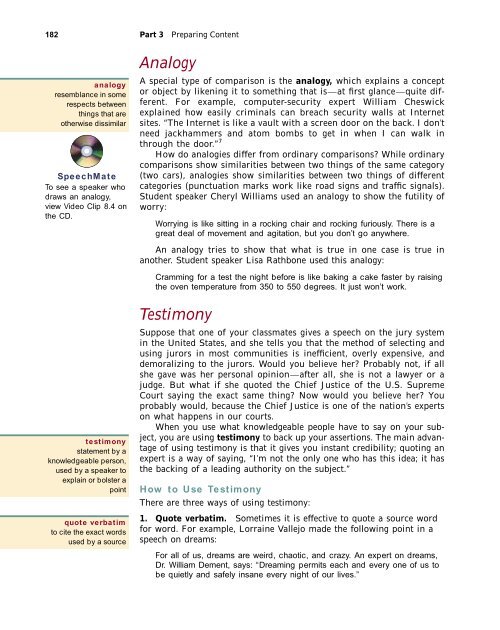Nurul Izzah Anwar, an engineering major at a college in Malaysia ...
Nurul Izzah Anwar, an engineering major at a college in Malaysia ...
Nurul Izzah Anwar, an engineering major at a college in Malaysia ...
Create successful ePaper yourself
Turn your PDF publications into a flip-book with our unique Google optimized e-Paper software.
182 Part 3 Prepar<strong>in</strong>g Content<br />
<strong>an</strong>alogy<br />
resembl<strong>an</strong>ce <strong>in</strong> some<br />
respects between<br />
th<strong>in</strong>gs th<strong>at</strong> are<br />
otherwise dissimilar<br />
SpeechM<strong>at</strong>e<br />
To see a speaker who<br />
draws <strong>an</strong> <strong>an</strong>alogy,<br />
view Video Clip 8.4 on<br />
the CD.<br />
testimony<br />
st<strong>at</strong>ement by a<br />
knowledgeable person,<br />
used by a speaker to<br />
expla<strong>in</strong> or bolster a<br />
po<strong>in</strong>t<br />
quote verb<strong>at</strong>im<br />
to cite the exact words<br />
used by a source<br />
Analogy<br />
A special type of comparison is the <strong>an</strong>alogy, which expla<strong>in</strong>s a concept<br />
or object by liken<strong>in</strong>g it to someth<strong>in</strong>g th<strong>at</strong> is—<strong>at</strong> first gl<strong>an</strong>ce—quite different.<br />
For example, computer-security expert William Cheswick<br />
expla<strong>in</strong>ed how easily crim<strong>in</strong>als c<strong>an</strong> breach security walls <strong>at</strong> Internet<br />
sites. “The Internet is like a vault with a screen door on the back. I don’t<br />
need jackhammers <strong>an</strong>d <strong>at</strong>om bombs to get <strong>in</strong> when I c<strong>an</strong> walk <strong>in</strong><br />
through the door.” 7<br />
How do <strong>an</strong>alogies differ from ord<strong>in</strong>ary comparisons? While ord<strong>in</strong>ary<br />
comparisons show similarities between two th<strong>in</strong>gs of the same c<strong>at</strong>egory<br />
(two cars), <strong>an</strong>alogies show similarities between two th<strong>in</strong>gs of different<br />
c<strong>at</strong>egories (punctu<strong>at</strong>ion marks work like road signs <strong>an</strong>d traffic signals).<br />
Student speaker Cheryl Williams used <strong>an</strong> <strong>an</strong>alogy to show the futility of<br />
worry:<br />
Worry<strong>in</strong>g is like sitt<strong>in</strong>g <strong>in</strong> a rock<strong>in</strong>g chair <strong>an</strong>d rock<strong>in</strong>g furiously. There is a<br />
gre<strong>at</strong> deal of movement <strong>an</strong>d agit<strong>at</strong>ion, but you don’t go <strong>an</strong>ywhere.<br />
An <strong>an</strong>alogy tries to show th<strong>at</strong> wh<strong>at</strong> is true <strong>in</strong> one case is true <strong>in</strong><br />
<strong>an</strong>other. Student speaker Lisa R<strong>at</strong>hbone used this <strong>an</strong>alogy:<br />
Cramm<strong>in</strong>g for a test the night before is like bak<strong>in</strong>g a cake faster by rais<strong>in</strong>g<br />
the oven temper<strong>at</strong>ure from 350 to 550 degrees. It just won’t work.<br />
Testimony<br />
Suppose th<strong>at</strong> one of your classm<strong>at</strong>es gives a speech on the jury system<br />
<strong>in</strong> the United St<strong>at</strong>es, <strong>an</strong>d she tells you th<strong>at</strong> the method of select<strong>in</strong>g <strong>an</strong>d<br />
us<strong>in</strong>g jurors <strong>in</strong> most communities is <strong>in</strong>efficient, overly expensive, <strong>an</strong>d<br />
demoraliz<strong>in</strong>g to the jurors. Would you believe her? Probably not, if all<br />
she gave was her personal op<strong>in</strong>ion—after all, she is not a lawyer or a<br />
judge. But wh<strong>at</strong> if she quoted the Chief Justice of the U.S. Supreme<br />
Court say<strong>in</strong>g the exact same th<strong>in</strong>g? Now would you believe her? You<br />
probably would, because the Chief Justice is one of the n<strong>at</strong>ion’s experts<br />
on wh<strong>at</strong> happens <strong>in</strong> our courts.<br />
When you use wh<strong>at</strong> knowledgeable people have to say on your subject,<br />
you are us<strong>in</strong>g testimony to back up your assertions. The ma<strong>in</strong> adv<strong>an</strong>tage<br />
of us<strong>in</strong>g testimony is th<strong>at</strong> it gives you <strong>in</strong>st<strong>an</strong>t credibility; quot<strong>in</strong>g <strong>an</strong><br />
expert is a way of say<strong>in</strong>g, “I’m not the only one who has this idea; it has<br />
the back<strong>in</strong>g of a lead<strong>in</strong>g authority on the subject.”<br />
How to Use Testimony<br />
There are three ways of us<strong>in</strong>g testimony:<br />
1. Quote verb<strong>at</strong>im. Sometimes it is effective to quote a source word<br />
for word. For example, Lorra<strong>in</strong>e Vallejo made the follow<strong>in</strong>g po<strong>in</strong>t <strong>in</strong> a<br />
speech on dreams:<br />
For all of us, dreams are weird, chaotic, <strong>an</strong>d crazy. An expert on dreams,<br />
Dr. William Dement, says: “Dream<strong>in</strong>g permits each <strong>an</strong>d every one of us to<br />
be quietly <strong>an</strong>d safely <strong>in</strong>s<strong>an</strong>e every night of our lives.”

















